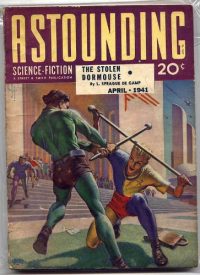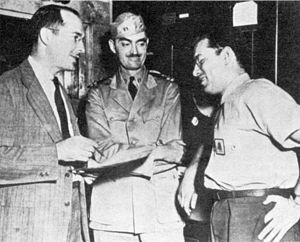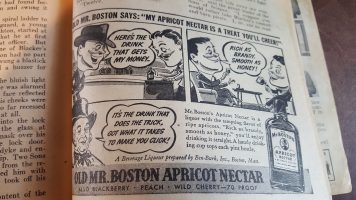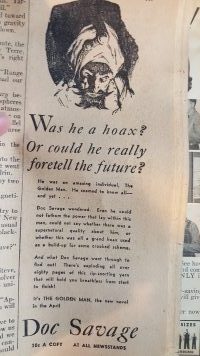Greetings all

This week I’m going to review Astounding, Vol. XXVII, No. 2 (April, 1941). You can find its complete table of contents here: http://www.isfdb.org/cgi-bin/pl.cgi?57379.
Unlike last week, where the Spaceway had few recognizable names, this issue is filled with them. John W. Campbell was the editor and if you ever wondered how much Campbell actually did, take a look at his full ISFDB page: http://www.isfdb.org/cgi-bin/ea.cgi?14. Wow. He starts this issue off with a short essay pointing out the importance of sea-water sources in the future.

Anyway, there will be a bunch you’ll recognize in this review, starting with the Feature Serial The Stolen Dormouse by L. Sprague de Camp. I probably don’t have to talk about him very much, as well-known as he is, but I do have to put up this picture from when he worked with Robert Heinlein, and Isaac Asimov researching for the Philadelphia Navy Yard in World War II. What an amazing picture, and reminiscent of J.R.R. Tolkien, C.S. Lewis, and the Inklings, though I suspect these three did not have anywhere as comfortable as The Eagle and Child to chat about their writing. On the other hand, they probably got to at least watch the building of the USS New Jersey (BB-62) and the USS Wisconsin (BB-64).
Before even reading the story, though, I had my nose rubbed in one of my weaknesses: taglines. “The Stolen Dormouse: Part One of a new serial concerning a stolen semi-corpse – an engineer in suspended animation touches off a war in a later-day feudalism!” (Astounding, Vol. XXVII, No. 2, p. 9).
You had me at “stolen semi-corpse.”
I really enjoyed the story, especially the way de Camp interwove 1940s business terminology with feudalism. As an SCA ceremonial geek, I found the passage where the hero, Horace Juniper-Hallett is elevated to the rank of businessman delightful. “I hereby present to you the gold-inlaid fountain pen and the brief case that are the insignia of your new status. Guard them with your life” (p. 12).
Getting to wallow in the history of science fiction and fantasy is one of the prime joys of this exercise, but The Stolen Dormouse highlights the greatest drawback. This is Part One of the story. I have no idea when, or even if, I’ll grab the volume with Part Two. At this point, the story ends with, “A snore answered her” (p. 32).
At least I have Reason by Isaac Asimov to console me. This story is a robot story, but before the Three Laws of Robotics, which were originally published in the story Runaround first publish in the Astounding of March, 1942. It involves a robot who refuses to believe that humans invented it or, in fact, that anything exists outside of its mile-diameter solar energy generation station, completely dismissing Gregory Donovan and Mike Powell’s protestations. Despite, QT’s religious obsession with the “Master,” the robot continues to perform his duties at a level far surpassing human abilities. In other words, even though his “reasoning” is based on false assumptions, he retains his ability to do the job so they leave him in place and in fact plan to program all future models in the same way.
What’s fun, of course, is that it’s clear that Asimov is working his way up to the Three Laws. In Runaround Donovan and Powell return, this time with the explicit use of the laws. But that’s another issue, which might be on the shelves behind. I don’t rightly now, though I will do September, 1941 one of these days, which includes Nightfall.
Anyway, next we move on to Theodore Sturgeon’s Microcosmic God. I love this sentence, “He never opened his mouth without grabbing a stickful of question marks.” (p. 47). The character he’s talking about is a bio-chemist named Kidder who creates a microcosmic race called the Neoterics who are fantastically intelligent. Their life cycle is much faster than humans, meaning that problems that take scientists generations to solve are solved much quicker, as their generations are that much shorter.
Kidder is oblivious of power and money, except when that allows him to expand his laboratory. Of course, not everyone is oblivious and his banker finally decides to kill the golden goose. In the end, the Neoterics create an impenetrable shield for Kidder, another scientist named Johansen, and the Neoterics to live out their lives in peace.
It’s a fantastic story and is included in The Science Fiction Hall of Fame, Volume One, 1929–1964. Let’s see, three stories in and we have a fun serial, a prequel to the Three Laws of Robotics, and one of the best short stories in science fiction history. Talk about the Golden Age of Science Fiction.
Next is Campbell’s column about what’s to come in the May, 1941 issue. The column talks about a story by Anson MacDonald called Solution Unsatisfactory. The story is about what happens if there’s a superweapon and what happens after that. In the story, all the solutions are unsatisfactory, but MacDonald goes through a number of them. “And MacDonald suggests that the weapon will come – and come in about three years. Personally, I’m most desperately afraid he’s absolutely correct. Now, remember this is April, 1941. Missed the prediction by a little more than a year, but is a fascinating question to someone who grew up during the Cold War.
Oh, and Anson MacDonald is one of Heinlein’s pseudonyms.
Anyway, we move on The Scrambler by Harry Walton. This story starts something like Moby Dick, in that a ship is trying to capture a living creature in space to help a man named Storm, who is searching for intelligent alien life. They succeed, though the captain is convinced it happened too easily. However, neither Storm nor the captain believe this could be the one until suddenly they find their personalities scrambled from man to man. They try to do roll call, but the personalities keep switching. Finally, they realize that Storm has actually had his personality switched with Comet the ship cat. The creature was testing the crew, and if they could realize Storm was in Comet’s body, learn from Storm that it was the creature’s doing while he was still a cat, they would all return to their rightful bodies.
So Storm has to endure the entire thing trying to get everyone to listen to him while as a cat. Oh, and it turns out that Comet had had a big night with a cat at the Martian fuel depot and was pregnant. A fun story, not a classic, but well worth reading.
Slacker’s Paradise by Malcolm Jameson is next. Another officer in the US Navy, he was forced out by cancer despite helping improve late World War II-era naval ordinance. He died in 1945 at the age of 53. It’s a damn shame, too, because Slacker’s Paradise is a great story.
Jameson uses his experience in the Navy and his knowledge of naval history to create something that would make a fantastic series of novels. This particular one draws on the surrender of the Austro-Hungarian battleships SMS Zrinyi and SMS Radetsky in 1918. The story is reminiscent of the Lieutenant Leary novels by David Drake. The only problem with Slacker’s Paradise is that it needs to be longer to draw out the tension.
Next is Not the First by A.E. van Vogt. In this story humans first break the light speed barrier, discovering that it shifts their perception of the universe they exist in. In so doing, it propels the ship at many thousands of times the speed of light. As it flies through the universe, their luck runs out and they find themselves sailing directly at a star so they try anything that comes to mind. In the end, they find a way to reverse time and send them back to where they were.
Right when the situation started with no change in the factors and for the “multi-billionth” time, the process begins again. Creepy. I like it.
Astronomer R.S. Richardson gives us our next article, Trepidation. While this is an excellent name for a short story, this is actually an article on trepidation in the astronomical sense. I found this article confusing because the only theory of trepidation in an astronomical sense has been obsolete for centuries. This trepidation has to do with the speeding up and slowing down of astronomical bodies, as discovered by E.W. Brown. That led to questions of measuring time, including the difference between Universal Time and Terrestrial Time, and fluctuations of mass.
Back to fiction, we get Bird Walk by P. Schuyler Miller. This was an odd story to me. Basically, the birds of Venus include one that can tell when someone is lying, and the hero manipulates the thief of one of the, essentially, Crown Jewels of Venus into being within range.
But the story didn’t work for me. It could have, but I think it might have tried to do too much. The red herrings were too easy and the hints at strange powers by other Venusian animals not dealt with well enough. It could be a good story but much of what was in there was extraneous and the mystery too easily solved.
Next is another odd essay, The Homemade Gun of Jamrud by Willy Ley. It’s only one page about 2.75 inch hand-crafted gun made by a blacksmith in Jamrud. It was apparently more accurate than the official British Army ones. And that’s all there is to this.

The next short story is Mutineers by Karl van Rachen, which is actually a pseudonym of L. Ron Hubbard. This was a frustrating story for me, maybe because I was tired when I read it. It’s got a lot of moving parts and there’s too much exposition at the start. I got into it some when we got past the exposition into the action, but by that point I had lost my enthusiasm.

And it could have been a good story. Multiple mutinies and various different players are right up my alley. The hero wins by good tactics, awareness, and flat out bluffing. There’s a bit of a forced happy ending, which I hate, but it’s not awful. However, I just didn’t get into it.
Another possible reason are the great ads throughout this story. It’s at the end of the issue, so there are more ads and some are just wonderful from my perspective. Old Mr. Boston 70 proof Apricot Nectar as shown above from page 135? Maybe, but you might have me with the Wild Cherry version. There was also this Doc Savage ad on page 147.
 But the piece de resistance was this wonderful Harley-Davidson ad. “See the 1941 models with their airplane styling, zooming power, rugged dependability and important mechanical improvements” (p. 145).
But the piece de resistance was this wonderful Harley-Davidson ad. “See the 1941 models with their airplane styling, zooming power, rugged dependability and important mechanical improvements” (p. 145).
The most common advertisements in this issue, by the way, were ads to train you as a radio operator.
Anyway, at the end of Mutineers was an interesting postscript that I assume was written by Hubbard, as it doesn’t have any other name attributed to it. It’s a very short essay entitled Two Plus Two Equals 100. Obviously, it explains the binomial number system and points out that it is useful for “electrical calculating machines.” (p. 154) As someone writing on a fairly up-to-date computer and looking at my cell phone, I enjoyed this quote: “The resultant machine is bulky, but simple and positive in action” (p. 154). You don’t say?
Now we’ve gotten down to Brass Tacks, the letter’s to the editor section of Astounding. Several of this issue’s letters discussed a new rating system put into place by Campbell. In these Slan by Van Vogt gets a lot of approval. There’s also an announcement for the formation of the Minneapolis Fantasy Society, whose monthly meetings were held at the home of Clifford D. Simak, its director.
Another laments that Campbell could not come to the Chicago SF Convention because, “I’d hoped to see you and Doc Smith exchange diverse comment as of yore – remember the days of your glorious feud over the alleged – who did win those battles? – chemical vagaries in ‘Skylark of Space'” (p. 159). That would have indeed been fun to watch.
Then there’s a section of letters relating to hard science. The first discussed some new, higher resolution images from Mars showing conclusively the canals. The next one starts, “From the results the R.A.F. have been obtaining with their electrical enemy-airplane detectors, it looks as though spaceships when, as and if, won’t have to worry about developing meteor-detecting devices” (p. 163-4). Then it goes on to explain in some detail how radar works and how it blunted the Luftwaffe’s attacks in the Battle of Britain. Nothing new to us, but fantastic to see it from someone to whom it was new.
Well, I think that’s it from this issue. Clearly since I’m only two issues in, it’s a little silly to say this was my favorite issue. I’m sure I’ll find others, like perhaps the Astounding with Nightfall when I get to it. However, this was a brilliant example of the SF magazine concept. Great stories, writers who would become legendary, good scientific discussions, and good artwork.
Speaking of which, I suppose I should talk more about the art, but I got too much into the stories. Maybe next time. Speaking of which, I grabbed Fantastic Universe Vol. 3, No. 2 from March 1955. It’s table of contents is here: http://www.isfdb.org/cgi-bin/pl.cgi?89712.
If you have any comments, feel free to comment here or send an email to me at: rob@robhowell.org.
If you want to see previous reviews, the Mag Review category is here: https://robhowell.org/blog/?cat=432.
